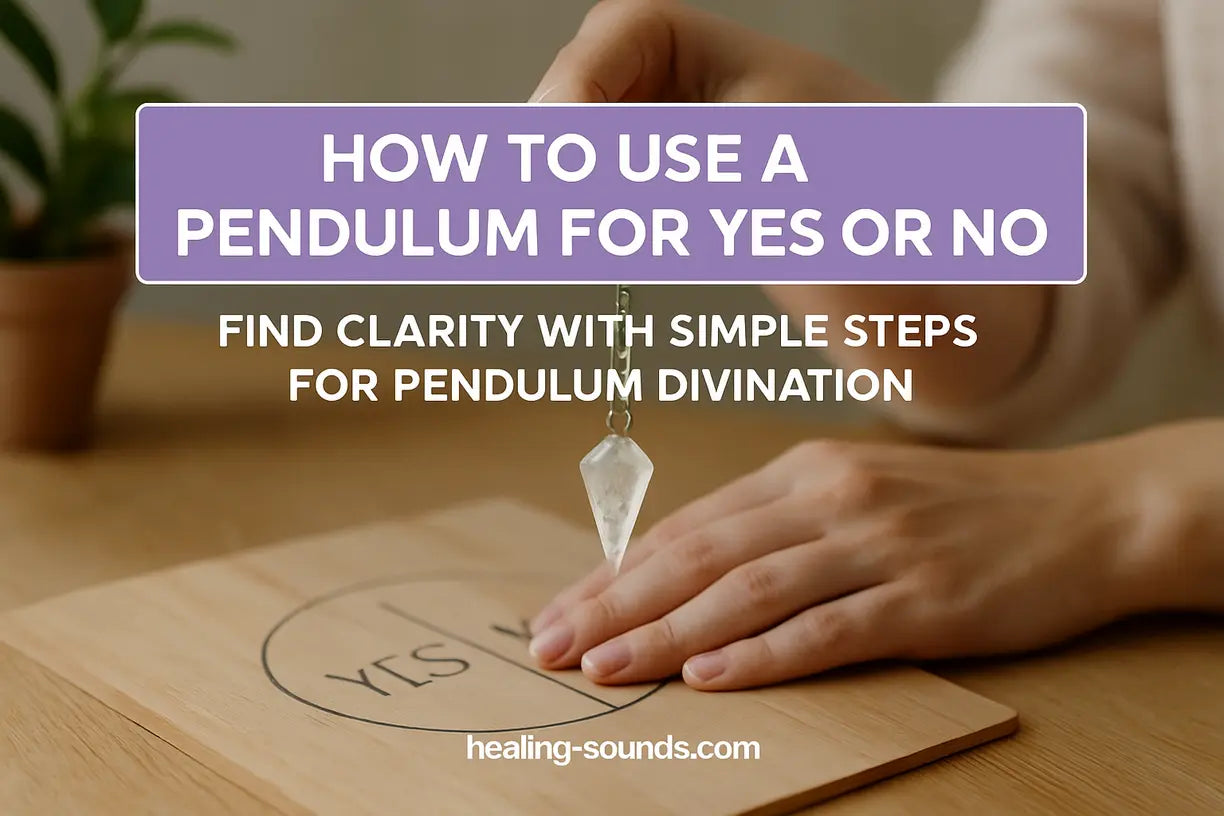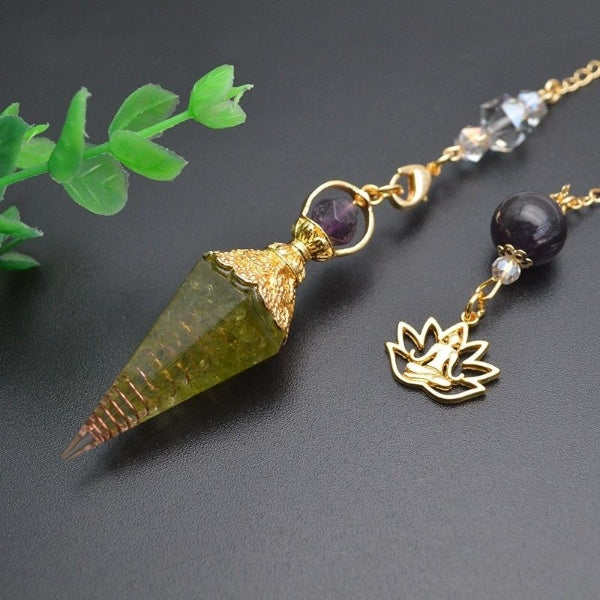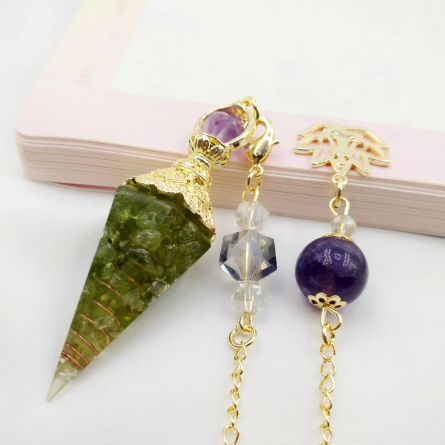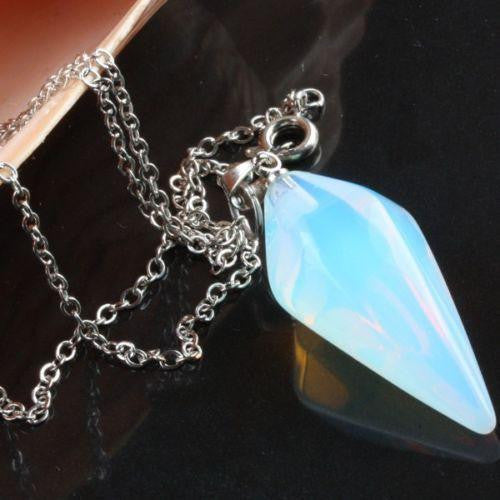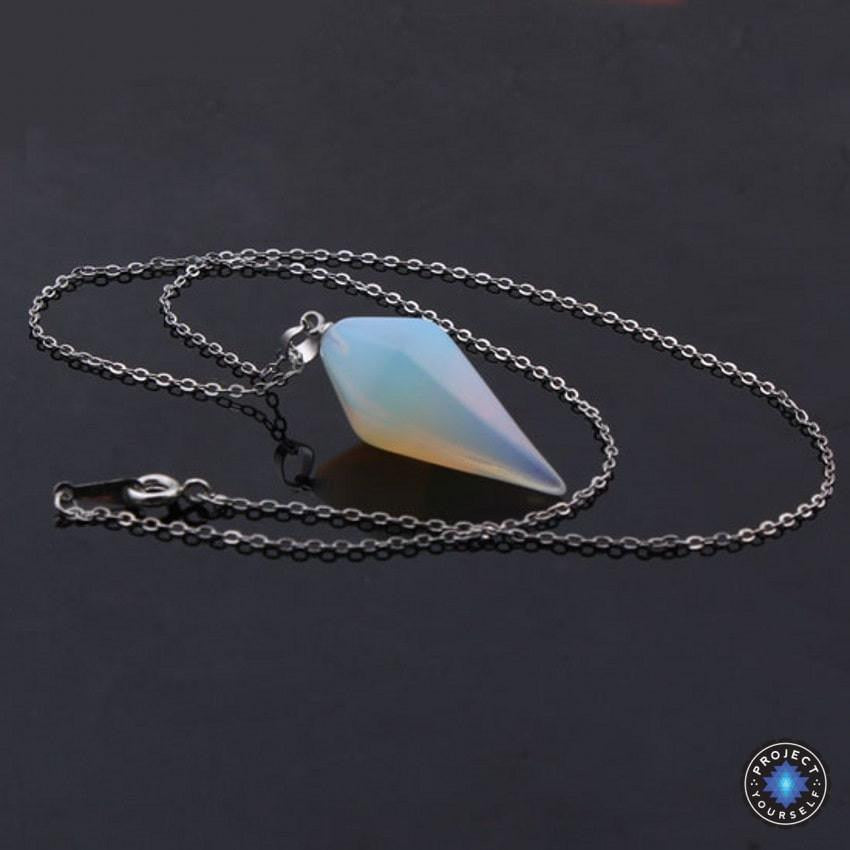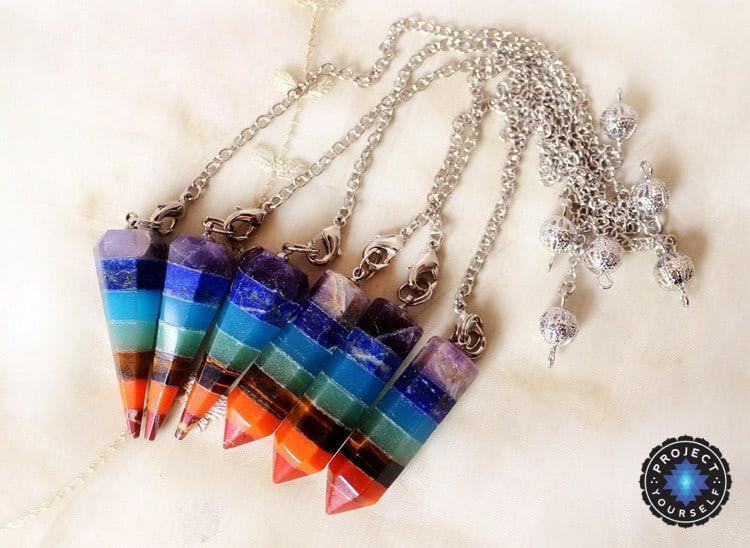Êtes-vous à la croisée des chemins, en quête d'un signe clair ou d'une simple réponse à une question qui vous taraude l'esprit ? Dans les moments d'incertitude, nous aspirons souvent à un lien direct avec notre sagesse intérieure. La lecture du pendule est une technique de divination puissante et simple qui peut vous aider à puiser dans votre intuition et à gagner en clarté. Cette pratique ancestrale ne vise pas à prédire un avenir figé, mais à révéler les réponses déjà présentes dans votre subconscient.
Que vous soyez débutant ou que vous cherchiez à perfectionner vos compétences, ce guide vous expliquera tout ce que vous devez savoir. Vous apprendrez à choisir, purifier et calibrer votre pendule, à maîtriser l'art de poser des questions pertinentes et à interpréter ses mouvements avec assurance. Préparez-vous à atteindre un niveau supérieur de conscience de soi et à recevoir les conseils que vous recherchez.
Qu'est-ce qu'un pendule et comment fonctionne-t-il ?
Un pendule est un outil simple, généralement un objet lesté, comme une boule de cristal ou de métal, suspendu à une chaîne ou un cordon. Immobile, il peut osciller dans différentes directions en réponse à de subtiles fluctuations énergétiques. La magie d'une lecture « oui ou non » au pendule réside dans sa connexion avec votre subconscient et votre moi supérieur. Les minuscules mouvements musculaires inconscients de votre main, appelés réponse idéomotrice, font bouger le pendule, traduisant les signaux subtils de votre intuition en mouvements clairs et visibles.
Considérez-la non pas comme une force extérieure vous apportant des réponses, mais comme une antenne sensible qui amplifie votre propre connaissance intérieure. Elle contourne le bavardage mental et le doute de votre esprit conscient, offrant un lien direct avec votre intuition pour une orientation claire.
Choisir votre premier pendule
Le facteur le plus important dans le choix d'un pendule est votre lien personnel avec lui. Vous pourriez être attiré par un cristal, une forme ou un poids spécifique. Les cristaux sont un choix populaire car ils possèdent des propriétés énergétiques uniques. Par exemple, l'améthyste est connue pour améliorer l'intuition, tandis que le quartz rose est associé au cœur et à la clarté émotionnelle. Essayez différents pendules et voyez lequel vous convient le mieux : vous recherchez celui qui est comme une extension naturelle de votre propre énergie.

Pour ceux qui débutent leur parcours, trouver un pendule conçu pour la clarté et la connexion est essentiel. Un outil bien conçu peut faciliter l'établissement d'un lien fort et l'obtention de réponses précises dès le départ.
Pendule en cristal d'orgone améthyste péridot
$49.99 $59.99
Faites l'expérience de réponses précises par oui ou par non avec ce pendule en cristal d'améthyste et de péridot rayonnant, idéal pour les débutants.
Explorer le produitLa première étape cruciale : comment calibrer votre pendule
Avant de pouvoir poser des questions à votre pendule, vous devez établir un système de communication clair. Ce processus, appelé calibrage, est l'étape la plus cruciale pour obtenir des réponses fiables. En fait, vous apprenez à votre pendule – et à votre subconscient – quels mouvements spécifiques correspondent à « oui », « non » et à d'autres réponses possibles. Les signaux de chaque personne peuvent être différents ; ne négligez donc jamais cette étape.
- Trouvez un endroit calme : Asseyez-vous confortablement dans un endroit calme où vous ne serez pas dérangé. Prenez quelques respirations profondes pour vous vider l'esprit et recentrer votre énergie.
- Tenez correctement le pendule : saisissez la chaîne ou le cordon entre le pouce et l’index, à environ 5 à 7,5 cm au-dessus de l’objet lesté. Posez votre coude sur une table pour stabiliser votre bras. Laissez le pendule pendre librement.
- Demandez « oui » : Une fois le pendule immobile, dites à voix haute ou mentalement : « Montrez-moi 'oui', s'il vous plaît. » Attendez patiemment et observez le mouvement. Il peut s'agir d'un mouvement d'avant en arrière, d'un mouvement latéral ou d'un cercle dans le sens des aiguilles d'une montre. C'est votre signal personnel pour dire « oui ».
- Demander « Non » : Arrêtez le pendule et laissez-le s'immobiliser. Maintenant, demandez : « Montrez-moi 'non', s'il vous plaît. » Observez attentivement le nouveau mouvement. Il sera nettement différent de votre signal « oui » (par exemple, si « oui » était un cercle, « non » pourrait être un balancement latéral).
- Demandez « Peut-être » : Il est également utile d'établir un signal pour « peut-être » ou de « formuler la question ». Arrêtez le pendule et demandez : « Montrez-moi “peut-être” », s'il vous plaît. Cela produit souvent un mouvement différent, comme une oscillation diagonale paresseuse ou un cercle dans le sens inverse des aiguilles d'une montre.
Pratiquez ce calibrage jusqu'à ce que vous soyez sûr de bien connaître vos signaux. Ce processus renforce la connexion et vous permet de vous fier aux réponses reçues. Une démonstration visuelle peut être extrêmement utile pour les débutants.
L'art de demander : comment formuler vos questions
La qualité de vos réponses dépend entièrement de la qualité de vos questions. Le pendule fonctionne mieux avec des questions claires et directes auxquelles on peut répondre par un simple « oui » ou « non ». Des questions vagues, émotionnelles ou à plusieurs volets ne mèneront qu'à des réponses confuses ou peu fiables.
Principes clés pour poser des questions :
- Soyez précis : au lieu de demander « Serai-je heureux ? », demandez-vous : « Est-ce que le fait d’accepter cette nouvelle offre d’emploi est dans mon plus grand bien en ce moment ? »
- Restez neutre : évitez les questions chargées d'émotion ou les formulations qui supposent déjà une réponse. Laissez votre curiosité, et non votre désir, guider la question.
- Concentrez-vous sur vous-même : Ne posez des questions que sur vous-même et votre parcours. S'immiscer dans la vie des autres est contraire à l'éthique et produit souvent des résultats inexacts.
- Une question à la fois : évitez les questions complexes comme « Devrais-je déménager en ville et trouver un nouvel emploi ? » Décomposez-les en plusieurs questions distinctes.
N'oubliez pas que votre objectif est de lever le plus d'ambiguïté possible. Poser des questions impartiales est une compétence qui se développe avec la pratique et est essentielle pour obtenir des indications claires de votre pendule.
[curseur de collection]
Interprétation des réponses et utilisation d'un graphique pendulaire
Une fois votre pendule calibré et votre question claire formulée, il est temps de chercher la réponse. Maintenez le pendule immobile, posez votre question et attendez patiemment qu'il commence à osciller. Adaptez le mouvement aux signaux « oui », « non » ou « peut-être » établis lors de l'étalonnage. Faites confiance à la première réponse positive obtenue.
Pour ceux qui préfèrent une méthode plus visuelle, un tableau pendulaire « oui-non » peut être un excellent outil. Ces tableaux, que vous pouvez imprimer ou dessiner vous-même, comportent généralement les options « Oui », « Non », « Peut-être » et « Reformuler » inscrites dans différents quadrants. Il suffit de maintenir le pendule au-dessus du centre du tableau et de poser la question. La direction dans laquelle il oscille indique la réponse.

Utiliser différents outils pour répondre à différents besoins énergétiques peut également améliorer votre pratique. Certains cristaux sont excellents pour purifier votre champ aurique avant une séance, assurant une connexion optimale, tandis que d'autres sont conçus pour aligner vos centres énergétiques et vous offrir un accompagnement plus holistique.
Outils pour une divination plus claire
$19.99
$29.99
Purifiez votre énergie et recevez des conseils clairs par oui ou par non en utilisant ce pendule en cristal d'opale, un incontournable pour les séances de divination. En savoir plus ➔
$29.99
$39.99
Débloquez l'harmonie des chakras et des réponses oui/non fiables avec ce pendule en cristal de pierre précieuse fabriqué à la main pour une clarté spirituelle. En savoir plus ➔
Dépannage : que faire lorsque votre pendule ne répond pas
Il arrive que votre pendule ne bouge pas du tout, ou oscille de manière erratique. Ne vous découragez pas ! Ce n'est généralement pas un signe d'échec, mais plutôt un signe qu'un ajustement est nécessaire. Voici quelques raisons et solutions courantes :
- Votre esprit est confus : Si vous vous sentez stressé, anxieux ou trop attaché à un objectif précis, votre énergie peut perturber votre concentration. Faites une pause, méditez quelques minutes et réessayez lorsque vous vous sentirez plus centré.
- La question n'est pas claire : Un manque de mouvement peut signifier que la question est trop vague, complexe ou qu'elle ne répond pas vraiment par oui ou par non. Essayez de la reformuler pour la rendre plus précise et directe.
- Votre pendule a besoin d'être purifié : Comme tout autre outil spirituel, le pendule peut absorber l'énergie stagnante au fil du temps. Vous pouvez purifier votre pendule en le purifiant avec de la sauge, en le laissant au clair de lune ou en le plaçant sur une plaque de charge en sélénite.
- Ce n'est pas le bon moment : Parfois, la réponse n'est pas encore connue ou vous n'êtes pas censé la connaître à ce moment précis. Acceptez-le et revenez à la question un autre jour.
Suivre un processus clair et simple est le meilleur moyen de garantir des résultats cohérents et fiables lors de votre parcours de divination.

Conclusion : Faire confiance à votre guidance intérieure
Apprendre à utiliser un pendule pour répondre par oui ou par non est un cheminement de découverte de soi et de confiance. En suivant les étapes consistant à choisir un outil qui résonne, à l'adapter à votre énergie unique, à poser des questions claires et à interpréter ses réponses, vous accédez à une méthode puissante pour vous connecter à votre intuition. N'oubliez pas que le pendule n'est pas un oracle extérieur ; c'est un miroir reflétant la sagesse que vous portez déjà en vous.
Adoptez cette pratique avec un cœur ouvert et un esprit curieux. Plus vous travaillerez avec votre pendule, plus votre connexion se renforcera. Commencez votre voyage dès aujourd'hui et découvrez la clarté et la confiance que procure l'écoute de votre voix intérieure. Pour une explication approfondie de la science derrière ce phénomène, vous pouvez explorer les recherches sur l' effet idéomoteur , qui offrent un aperçu fascinant du lien corps-esprit.
Questions fréquemment posées sur l'utilisation d'un pendule pour oui/non
Le « oui » et le « non » d'un pendule sont propres à chaque utilisateur et doivent être déterminés par étalonnage. Pour une personne, le « oui » peut correspondre à un cercle dans le sens des aiguilles d'une montre et le « non » à un mouvement d'avant en arrière. Pour une autre, ce peut être l'inverse. Il n'existe pas de règle universelle ; vous devez demander à votre pendule de vous indiquer ses signaux spécifiques pour chaque réponse.
Vous pouvez savoir si un pendule dit « oui » ou « non » en observant son mouvement et en le comparant aux signaux établis lors de votre séance d'étalonnage. Après avoir posé une question claire, observez s'il oscille dans la direction prédéterminée (oui ou non). Faites confiance au premier mouvement clair et soutenu que vous recevez.
Si votre pendule ne répond pas ou reste immobile, plusieurs raisons peuvent expliquer ce phénomène. Vous ressentez peut-être du stress ou un attachement émotionnel au résultat, la question est peut-être floue, ou le pendule a peut-être besoin d'être nettoyé énergétiquement. Essayez de méditer pour vous recentrer, de reformuler la question pour la rendre plus précise, ou de nettoyer votre pendule avec de la sauge ou de la lumière lunaire.
Il n'existe pas de sens unique pour le « oui ». Les mouvements courants incluent un mouvement vertical (d'avant en arrière), horizontal (d'un côté à l'autre) ou circulaire dans le sens des aiguilles d'une montre. Le sens précis du « oui » est personnel, propre à vous et à votre pendule. Vous devez déterminer votre propre signal « oui » grâce au processus d'étalonnage, en demandant à votre pendule : « Montrez-moi oui ».
Pour calibrer un pendule, maintenez-le immobile et demandez-lui : « Montrez-moi "oui" ». Notez la direction du balancement. Arrêtez-le, puis demandez-lui « Montrez-moi "non" » et observez ce mouvement particulier. Vous pouvez également demander un signal « peut-être ». Ce processus établit une communication claire entre vous et votre pendule pour des réponses fiables.

